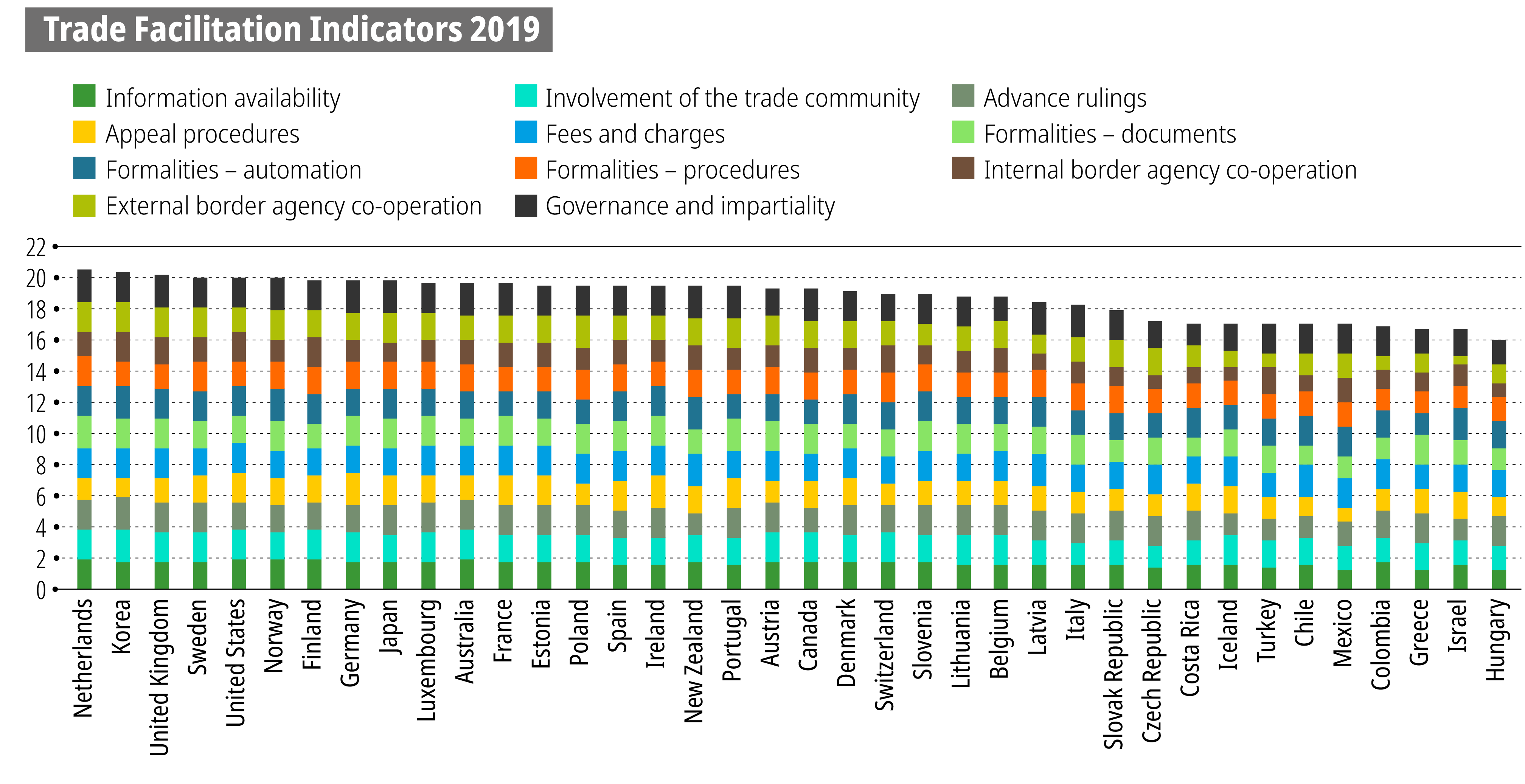Issue
Trade facilitation underpins global supply chains, reducing the time and cost of moving goods around the world and promoting more inclusive trade. Reducing trade costs is particularly important for micro, small and medium-sized enterprises (MSMEs). The most common disruptions reported by firms during COVID-19 were not so much related to their suppliers, but to difficulties at the border when exporting or importing goods. Trade facilitation is critical during a crisis to ensure the smooth movement of essential goods across borders.
The OECD Trade Facilitation Indicators (TFIs, covering over 160 countries and linked to the WTO Trade Facilitation Agreement) highlight the areas where countries can do more, including transparency and predictability, streamlining and automating border processes, and co-operation among border agencies. These facilitating measures are particularly important for the distribution of vaccine(s) and related inputs. The speed and efficiency of border processes is also of particular importance for agro-food products, as delays at the border can have great negative impacts on the quality of perishable agro-food products and hence their value.In addition, the growing number and diversity of digitally ordered parcels crossing borders means that border agencies need to manage risks over a more numerous set of consignments while aiming to facilitate trade of all safety- and quality-approved products.
Digitalisation was key in supporting the many efforts made to facilitate trade during the COVID-19 crisis. Trade facilitating measures included designing “green lanes” for streamlining border controls or exchanging specific trade documents electronically (including electronic sanitary and phytosanitary certificates). Many of these reforms are win-win reforms that could outlast the pandemic, and lessons about what worked can support additional reforms both to the benefit of the economy in normal times and in promoting the resilience of trade to a range of future shocks.
Policy action
- International co-operation with continued impetus towards the sustained implementation of the WTO Trade Facilitation Agreement
- Streamline border processes (e.g. increasing the share of trade transactions covered by pre-arrival processing; green lanes for essential goods)
- Digitalisation of border processes (e.g. digital trade documents, certificates and signatures)
- More efficient co-operation between agencies at borders (e.g. enhanced cross-border co-operation in border risk management)
- Facilitating product certification (e.g. streamlining certification procedures; use and adoption of international standards; more flexible application of product certification criteria in emergencies)
Related tools & publications
- Trade facilitation in perishable agro-food products: A feasibility study for addressing at-the-border challenges
- Digital opportunities for Sanitary and Phytosanitary (SPS) Systems and the trade facilitation effects of SPS Electronic Certification
- OECD (2018), Trade Facilitation and the Global Economy, OECD Publishing, Paris.
- López González, J. and S. Sorescu “Trade in the time of parcels”, OECD Trade Policy Papers, No. 249, OECD Publishing, Paris.
- López González, J. and S. Sorescu (2019), "Helping SMEs internationalise through trade facilitation", OECD Trade Policy Papers, No. 229, OECD Publishing, Paris.
- OECD (2021), “Using trade to fight COVID-19: Manufacturing and distributing vaccines”, OECD Policy Responses to Coronavirus (COVID-19)
- OECD (2020), “Trade Facilitation and the COVID-19 Pandemic”, OECD Policy Responses to Coronavirus (COVID-19)
- OECD (2020), "Getting Goods Across Borders in Times of COVID-19", OECD Policy Responses to Coronavirus (COVID-19), OECD Publishing, Paris
- OECD (2020), “Connecting businesses and consumers during COVID-19: Trade in parcels”, OECD Policy Responses to Coronavirus (COVID-19)
- Moïsé, E. and S. Sorescu (2015), "Contribution of Trade Facilitation Measures to the Operation of Supply Chains", OECD Trade Policy Papers, No. 181, OECD Publishing, Paris.
- Moïsé, E. and S. Sorescu (2013), "Trade Facilitation Indicators: The Potential Impact of Trade Facilitation on Developing Countries' Trade", OECD Trade Policy Papers, No. 144, OECD Publishing, Paris.
- WTO, Trade Facilitation Agreement Facility, COVID-19 Trade Facilitation Resource Repository
|

